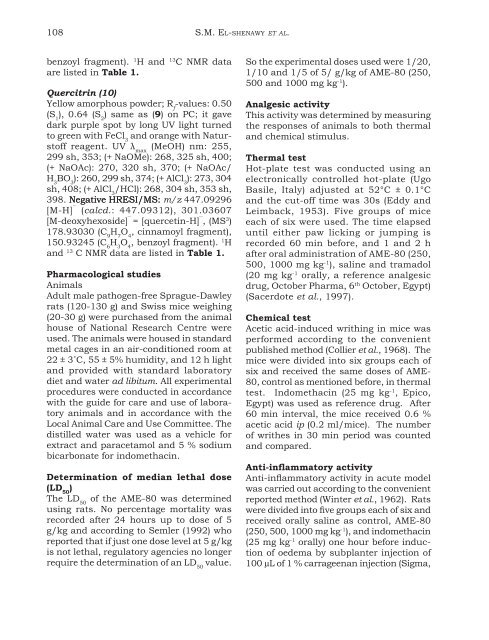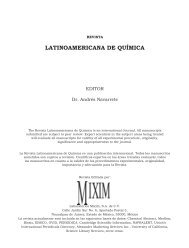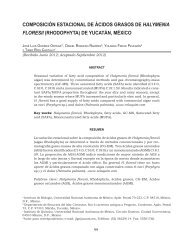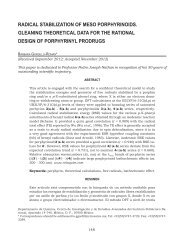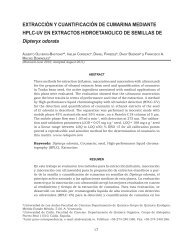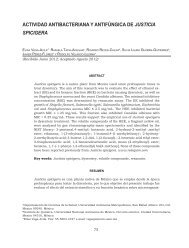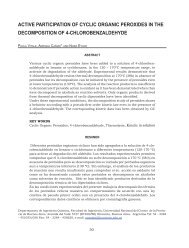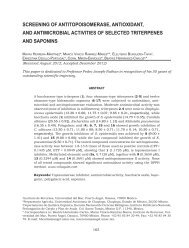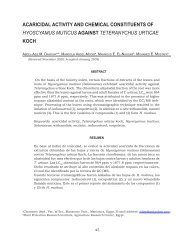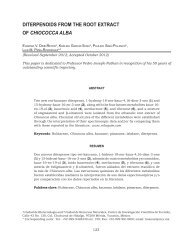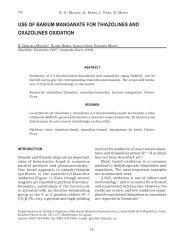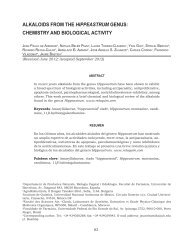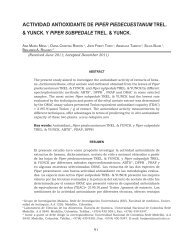POLYPHENOLS AND BIOLOGICAL ACTIVITIES OF Feijoa ...
POLYPHENOLS AND BIOLOGICAL ACTIVITIES OF Feijoa ...
POLYPHENOLS AND BIOLOGICAL ACTIVITIES OF Feijoa ...
You also want an ePaper? Increase the reach of your titles
YUMPU automatically turns print PDFs into web optimized ePapers that Google loves.
108 S.M. El-shenawy et al.<br />
benzoyl fragment). 1 H and 13 C NMR data<br />
are listed in Table 1.<br />
Quercitrin (10)<br />
Yellow amorphous powder; R f<br />
-values: 0.50<br />
(S 1<br />
), 0.64 (S 2<br />
) same as (9) on PC; it gave<br />
dark purple spot by long UV light turned<br />
to green with FeCl 3<br />
and orange with Naturstoff<br />
reagent. UV λ max<br />
(MeOH) nm: 255,<br />
299 sh, 353; (+ NaOMe): 268, 325 sh, 400;<br />
(+ NaOAc): 270, 320 sh, 370; (+ NaOAc/<br />
H 3<br />
BO 3<br />
): 260, 299 sh, 374; (+ AlCl 3<br />
): 273, 304<br />
sh, 408; (+ AlCl 3<br />
/HCl): 268, 304 sh, 353 sh,<br />
398. Negative HRESI/MS: m/z 447.09296<br />
[M-H] ‾ (calcd.: 447.09312), 301.03607<br />
[M-deoxyhexoside] ‾ = [quercetin-H] ‾ , (MS 3 )<br />
178.93030 (C 9<br />
H 7<br />
O 4<br />
, cinnamoyl fragment),<br />
150.93245 (C 6<br />
H 3<br />
O 4<br />
, benzoyl fragment). 1 H<br />
and 13 C NMR data are listed in Table 1.<br />
Pharmacological studies<br />
Animals<br />
Adult male pathogen-free Sprague-Dawley<br />
rats (120-130 g) and Swiss mice weighing<br />
(20-30 g) were purchased from the animal<br />
house of National Research Centre were<br />
used. The animals were housed in standard<br />
metal cages in an air-conditioned room at<br />
22 ± 3˚C, 55 ± 5% humidity, and 12 h light<br />
and provided with standard laboratory<br />
diet and water ad libitum. All experimental<br />
procedures were conducted in accordance<br />
with the guide for care and use of laboratory<br />
animals and in accordance with the<br />
Local Animal Care and Use Committee. The<br />
distilled water was used as a vehicle for<br />
extract and paracetamol and 5 % sodium<br />
bicarbonate for indomethacin.<br />
Determination of median lethal dose<br />
(LD 50<br />
)<br />
The LD 50<br />
of the AME-80 was determined<br />
using rats. No percentage mortality was<br />
recorded after 24 hours up to dose of 5<br />
g/kg and according to Semler (1992) who<br />
reported that if just one dose level at 5 g/kg<br />
is not lethal, regulatory agencies no longer<br />
require the determination of an LD 50<br />
value.<br />
So the experimental doses used were 1/20,<br />
1/10 and 1/5 of 5/ g/kg of AME-80 (250,<br />
500 and 1000 mg kg -1 ).<br />
Analgesic activity<br />
This activity was determined by measuring<br />
the responses of animals to both thermal<br />
and chemical stimulus.<br />
Thermal test<br />
Hot-plate test was conducted using an<br />
electronically controlled hot-plate (Ugo<br />
Basile, Italy) adjusted at 52°C ± 0.1°C<br />
and the cut-off time was 30s (Eddy and<br />
Leimback, 1953). Five groups of mice<br />
each of six were used. The time elapsed<br />
until either paw licking or jumping is<br />
recorded 60 min before, and 1 and 2 h<br />
after oral administration of AME-80 (250,<br />
500, 1000 mg kg -1 ), saline and tramadol<br />
(20 mg kg -1 orally, a reference analgesic<br />
drug, October Pharma, 6 th October, Egypt)<br />
(Sacerdote et al., 1997).<br />
Chemical test<br />
Acetic acid-induced writhing in mice was<br />
performed according to the convenient<br />
published method (Collier et al., 1968). The<br />
mice were divided into six groups each of<br />
six and received the same doses of AME-<br />
80, control as mentioned before, in thermal<br />
test. Indomethacin (25 mg kg -1 , Epico,<br />
Egypt) was used as reference drug. After<br />
60 min interval, the mice received 0.6 %<br />
acetic acid ip (0.2 ml/mice). The number<br />
of writhes in 30 min period was counted<br />
and compared.<br />
Anti-inflammatory activity<br />
Anti-inflammatory activity in acute model<br />
was carried out according to the convenient<br />
reported method (Winter et al., 1962). Rats<br />
were divided into five groups each of six and<br />
received orally saline as control, AME-80<br />
(250, 500, 1000 mg kg -1 ), and indomethacin<br />
(25 mg kg -1 orally) one hour before induction<br />
of oedema by subplanter injection of<br />
100 µL of 1 % carrageenan injection (Sigma,


